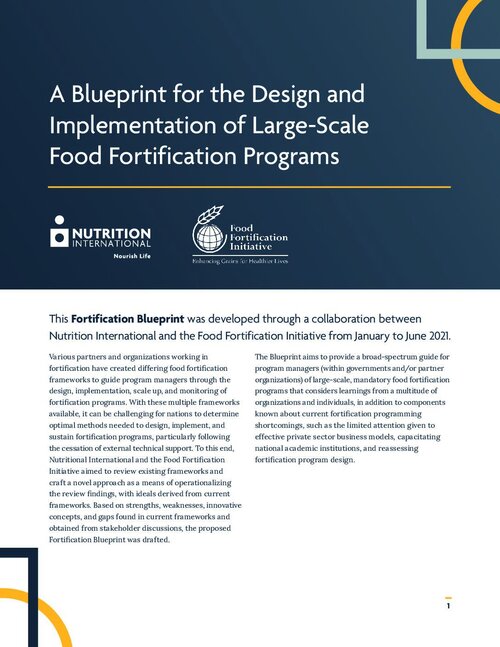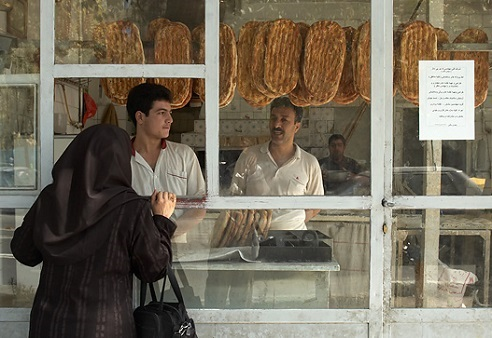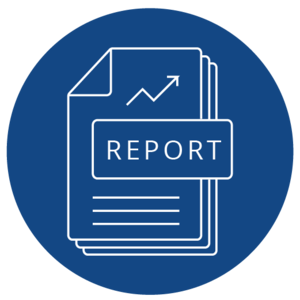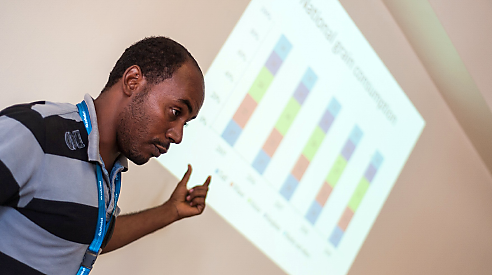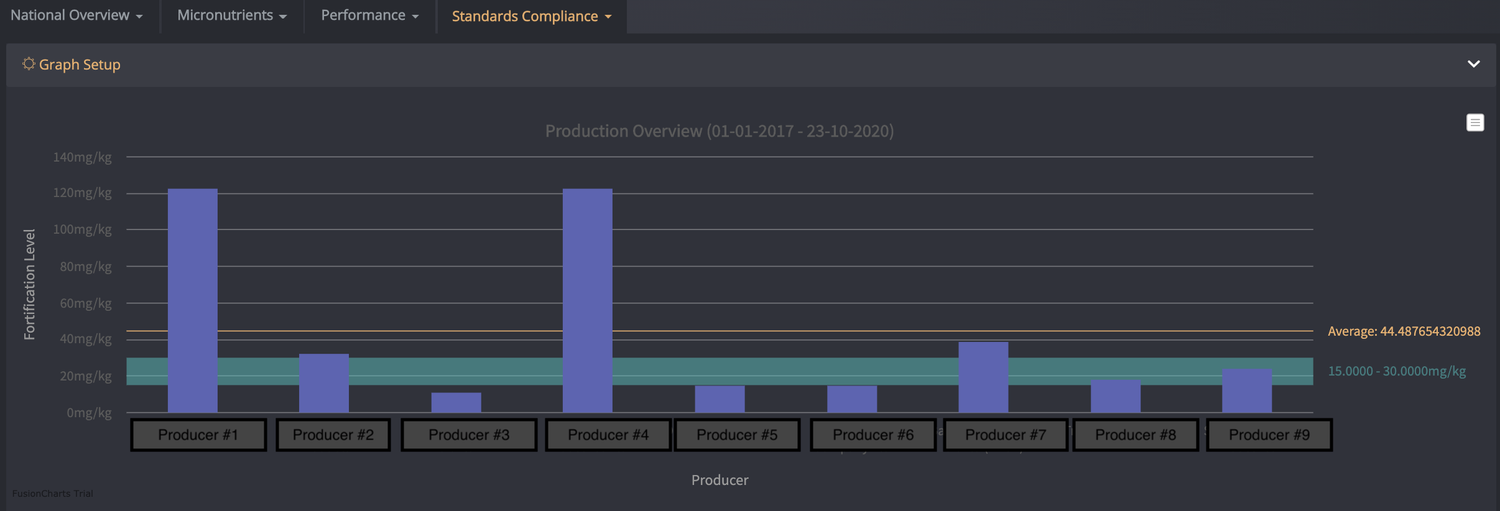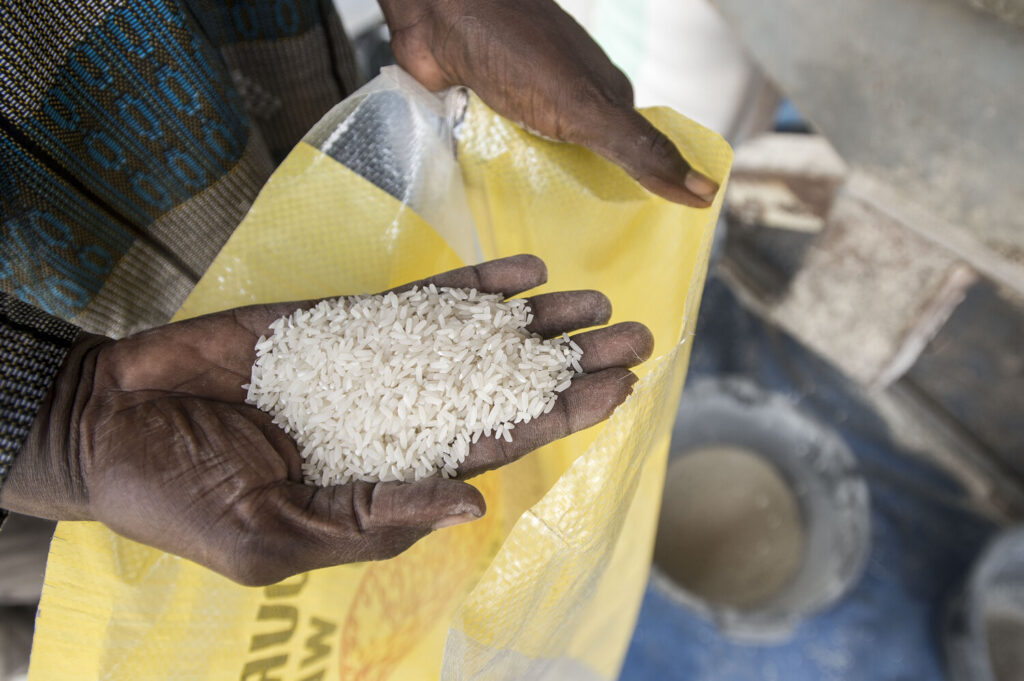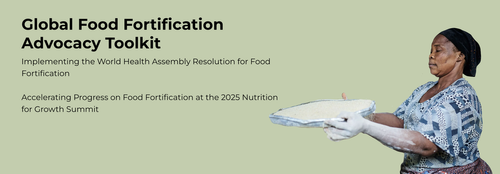Resources
Tools
Birth Defect Surveillance
Includes a manual for program managers and an online, self-paced course for health professional or other interested individuals – English, Español, Français

Photo: Steve Evans
Birth Defects Surveillance: A Manual for Program Managers is a tool for the development, implementation, and ongoing improvement of a birth defects surveillance program, particularly for countries with limited resources. The focus is on population-based and hospital-based surveillance programs. Any country wishing to expand its current hospital-based program into a population-based program, or to begin the initial development of a population-based registry, should find this manual helpful in reaching its goal. This manual is a collaborative effort between the World Health Organization (WHO), the National Center on Birth Defects and Developmental Disabilities from the United States Centers for Disease Control and Prevention (CDC) and the International Clearinghouse for Birth Defects Surveillance and Research (ICBDSR). It is available in English, Español, and Français.
Online Self-paced Course on Birth Defect Surveillance and Prevention is designed for clinicians, epidemiologists, public health professionals, and anyone interested in understanding birth defects and improving their prevention and care. The course includes videos, quizzes, a discussion forum, and publications/resources. It was developed by the International Centre on Birth Defects (ICBD – ICBDSR Centre) and supported in part by funding from the CDC’s National Center on Birth Defects and Developmental Disabilities through an agreement with the Task Force for Global Health. Once registered, you will receive access credentials, choose English or Español, and begin the course at your own convenience.
Blueprint for Food Fortification Program Design & Implementation
Produced in partnership with Nutrition International, “A Blueprint for the Design and Implementation of Large-Scale Food Fortification Programs” is based on a review and gap analysis of existing fortification frameworks. The Blueprint intends to refresh program thinking and priorities and provide renewed guidance concerning program components required to scale fortification initiatives and achieve nutrition impact goals. Further, the Blueprint intends to help better inform fortification programming policy and harmonize key design components, such as regulatory monitoring practices, creation of fortification standards, and identification of feasible fortification vehicles. Thus, the Blueprint aims to serve as a comprehensive guide for individuals or entities involved in leading or supporting the design and implementation of large-scale mandatory food fortification programs, including government agencies, supporting organizations, and/or individuals.
Case Studies
Offers lessons from fortification programs in Chile, Indonesia, Iran, Ireland, New Zealand, and South Africa.
“Flour Fortification in the Islamic Republic of Iran: Sustainable Route to Improved Health” provides detailed information on the country’s wheat flour fortification program development.
The flour fortification monitoring systems, challenges and successes from three countries are highlighted in the following case studies:
A case study from New Zealand details the country’s long journey to mandate fortification of wheat flour with folic acid to prevent neural tube defects.
Cost:Benefit
Workshops estimate the cost of implementing fortification programs compared to the economic benefits.
The cost:benefit tool assists countries in comparing the estimated cost of implementing a national food fortification program to the benefits the program will generate in return, also referred to as the program’s cost:benefit ratio. The tool is designed to be completed in a workshop setting with a trained facilitator. Countries need to provide data as illustrated in this spreadsheet, which is populated with data from an imaginary country called “Fortifitopia.”
For more information, contact Wilson Enzama, FFI Training and Technical Support Advisor: wenzama@gmail.com.
Document Checklist
Fortification legislation, standards, and monitoring often miss key items. Use this checklist to review your materials – English, Français, Russian, Español.
A review of grain fortification monitoring documents from 68 countries indicates that key elements are generally missing from the material. To help countries revise their documentation or establish new programs, the review authors created a 44-point checklist with sample text for food fortification legislation, standards, and monitoring policies.
Un examen des documents de 68 pays sur l’enrichissement des grains entiers constate que des éléments clés sont généralement omis de la documentation. Afin d’aider les pays à réviser leur documentation ou à élaborer de nouveaux programmes, les auteurs de l’examen ont créé une liste de vérification en 44 points, accompagnée d’un échantillon du type de langage à utiliser en ce qui a trait aux mesures législatives, les normes et les politiques de surveillance sur l’enrichissement des aliments.
Авторы проанализировали содержание документов, используемых в качестве руководства для Законодательство, правила ируководящие принципы были получены от стран с обязательной фортификацией пшеничной, кукуруризисикой кукуруриризисовой Данный вопросник и список критериев был создан на основе передовых практик и включает 44 пункта , которые должны быть включены в документы по фортификации.
Una nueva lista de 44 puntos para la legislación y estándares en fortificación de alimentos, y normas y políticas de monitoreo, is available for su uso in the revisión or el establecimiento de programas de fortificación.
FortifyMIS
Fortify Management Information System (FortifyMIS) is an online data collection and aggregation approach for food fortification monitoring
FortifyMIS is an online data collection and aggregation approach for fortification monitoring. The Management Information System (MIS) provides an improved means for food producers and government inspectors to monitor the quality of fortified products while providing decision makers with timely information to improve program performance.
FortifyMIS aims to:
Simplify the process of compliance data collection for national-level food inspectors and food producers
Improve how food control agencies are informed of implementation challenges
Developed by Project Healthy Children (PHC) and the Global Alliance for Improved Nutrition (GAIN), FortifyMIS can be used on computers, tablets, and handheld mobile devices. It allows for automatic tracking of fortified food quality and safety data using customizable digital forms, real-time dashboards, and tailored data reporting methods.
The platform aims to reduce the time and cost of monitoring and improve overall program performance by quickly tracking the quality of foods and identifying where improvements are needed. By using FortifyMIS, national governments and fortification stakeholders can better capture critical data needed to improve data-driven program outcomes.
The FortifyMIS platform provides:
A practical data aggregation solution for country-specific use;
More efficient and effective tracking of product compliance in real time to better understand whether fortified foods contain the amounts of vitamins and minerals per national standards; and
Data needed for countries to identify and act upon gaps to improve program outcomes in a timely, cost-effective, and sustainable manner.
By ensuring the delivery of adequate nutrients to target populations, FortifyMIS will be an integral component of global and national efforts to improve the nutritional benefits that fortification programs can offer to millions of consumers.
Users need their own login and permissions to view country data.
To see how the system works in training mode, contact Laura Rowe: laura.rowe@ffinetwork.org.
FORTIMAS
Fortification Monitoring and Surveillance is an approach for tracking the population coverage and impact of a food fortification program
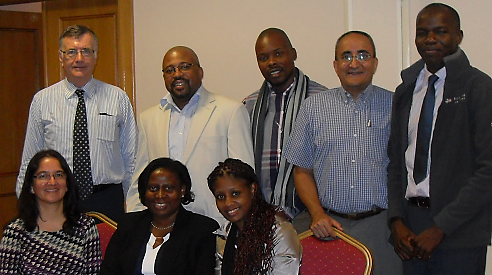
Photo: Smarter Futures
FORTIMAS (fortification monitoring and surveillance) is an approach for tracking the population coverage and impact of a flour fortification program. Users will assess trends in a limited number of program coverage and micronutrient status indicators in easy-to-reach target populations.
A key benefit of FORTIMAS is that it can be used with data already collected for other purposes, such as Demographic and Health Surveys (DHS) and other large-scale surveys. These are usually conducted at 5 to 10 year intervals. The FORTIMAS system will help countries identify trends in the interim period, such as whether maximum household coverage is reached and sustained in a given geographic area, and whether the health status of those who regularly consume fortified flour is improving.
Another example is that information on the number of newborns with neural tube defects (NTDs) is regularly gathered by large birthing hospitals in capital cities. The number of NTDs can be compared year after year in these hospitals to identify success or potential problems with the flour fortification program.
FORTIMAS was developed by Smarter Futures, a partnership for grain fortification in Africa. When FORTIMAS was developed, the partnership included AkzoNobel, FFI, Helen Keller International (HKI), the International Federation for Spina Bifida and Hydrocephalus (IF), and the Ministry of Foreign Affairs of the Netherlands.
FORTIMAS is available English, Français, and Português.
For information contact info@ffinetwork.org.
Zinc Spot Test
Qualitative spot tests for zinc in fortified wheat flour, maize flour, and rice
Developed under the guidance of the USAID Advancing Food Fortification Opportunities to Reinforce Diets (AFFORD) consortium, the purpose of the qualitative spot test is to quickly and inexpensively assess the presence of added zinc in fortified wheat flour, maize flour, and rice. Designed for both laboratory and field use, these tools empower professionals to ensure food fortification compliance with ease.
Xylenol Orange Test: Ideal for fortified wheat flour and white rice, this method uses xylenol orange in a phosphate buffer to create visible pink/purple spots where zinc is present.
Dithizone Test: Tailored for maize flour (yellow and white) and white or brown rice, this assay uses dithizone to detect zinc through distinct pink spots.
Both methods provide reliable results within 10–15 minutes and are safe, efficient, and validated for practical application.
Standards & Guidance
Documents available to help draft policy and to determine nutrients and levels of nutrients to include in fortified grains
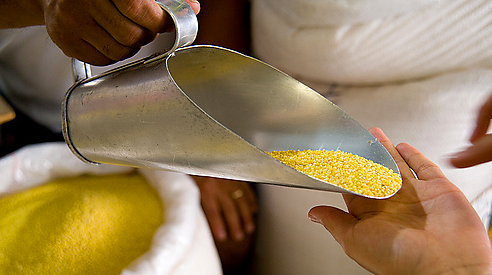
Photo: David Snyder, CDC Foundation/RTI
Standards
WHO guideline for fortifying wheat flour with vitamins and minerals.
WHO guidance on fortifying maize flour with iron, vitamin A, zinc and the following B vitamins: folic acid, niacin, pantothenic acid, pyridoxine riboflavin, thiamine, and vitamin B12.
WHO guidance for fortifying rice includes recommendations to fortify rice with iron, vitamin A, and folic acid as a public health strategy in settings where rice is a staple food.
Proposed nutrient and nutrient levels for rice fortification based on the per capita availability of rice. Nutrients included are folic acid, iron, vitamin B12, vitamin A, and zinc.
The Food Fortification Formulator is a series of spreadsheets that include dietary parameters for different gender and age groups, the price of commonly used fortificants, and the usual stability of vitamins and minerals during production, distribution, and marketing of fortified foods. The Formulator can be adjusted to different consumption patterns and tailored to each country’s specific conditions to generate suggested levels of addition for each fortificant. It is designed to assist in determining the potential additional intakes of vitamins and minerals for populations following efficacious and safety comparisons; the costs associated with food fortification programs; the fortification levels that can be used as technical specifications in the factories, national standards and regulations; and the amount of fortificant to be added in the micronutrient premixes. Directions for using it being on page 19 of this document.
Monitoring
WHO Monitoring Manual for Millers, Regulators, and Programme Managers (2021)
FFI Monitoring Framework Shell (2021). This tool takes recommendations from FFI and partners’ 2018 Regulatory Monitoring Guidance and puts it into a fillable form. The template allows countries to add unique context with the general recommendations and processes already filled in. This is one of two tools that can be used as a complement to the WHO Monitoring Manual (2021).
Regulatory Monitoring of National Food Fortification Programs: A Policy Guidance Document (2018). The document proposes a standardized, feasible approach to determining fortification compliance and offers country-specific examples for addressing common, ongoing challenges faced by public and private sectors. This is one of two tools that can be used as a complement to the WHO Monitoring Manual (2021). The document is available in English, Español, Français, and Russian.
For more information, contact info@ffinetwork.org.
Summaries
Documents that highlight the evidence for fortifying food with essential vitamins and minerals
Economic impact of iron deficiency and brain and spine birth defects (also called neural tube defects)
Effectiveness of fortifying flour with folic acid to prevent brain and spine birth defects
Effectiveness of fortifying flour with iron to prevent iron deficiency
Effectiveness of fortifying wheat flour to reduce prevalence of anemia
Evidence for fortifying wheat flour with folic acid and vitamin b12
Rice fortification evidence, status, and lessons learned
Communications Tools
Food fortification advocacy includes a general advocacy toolkit as well as a toolkit specifically for use by people advocating to prevent brain and spine birth defects in Africa

Photo: Global Alliance for Improved Nutrition
A general food fortification advocacy toolkit as well as a toolkit specifically for use by people advocating to prevent brain and spine birth defects in Africa. The Fortification Communications Toolkit and accompanying workbook can help you plan and conduct a communications campaign to inspire people to take action for food fortification.
The toolkit guides you through eight steps including:
Determining the campaign focus
Selecting target audiences and determining objectives
Understanding the audiences’ perceived barriers and benefits to food fortification
Developing a communications strategy
Developing activities
Setting a budget
Developing monitoring and evaluation plans
Implementing and adjusting as needed
Another toolkit is designed for people advocating for fortification programs as a means of preventing brain and spine birth defects in Africa. It could easily be adapted for use in other regions.
For more information, contact Jessie Genoway, FFI Communications Director: jessie.genoway@ffinetwork.org.
Corn Masa Fortification Communications Toolkit
Downloadable resources to advocate for corn masa fortification
The FFI Corn Masa Fortification Communications Toolkit is for anyone interested in strengthening health in the Latine community. We have divided the toolkit into sections based on our key audiences: vendors of corn masa products (e.g. grocery stores), manufacturers of corn masa products, and consumers of corn masa products.
What’s included in the toolkit?
Background information
Key messages
Suggested social media posts and graphics
Posts for producers
Posts for vendors
Posts for consumers
References
For more information, contact Sharon Bustrak, FFI Technical Advisor: sharon.bustrak@emory.edu.
Flour Millers Toolkit
A set of PowerPoint slides with basic food fortification implementation information for wheat and maize flour millers

Photo: David Snyder/CDC Foundation
The Flour Millers Toolkit offers basic information for wheat and maize flour fortification. The toolkit is a set of PowerPoint slides that include speaker notes for more information.
Among the technical topics covered are:
The most common way to fortify flour is using a micro feeder. This adds premix to flour at pre-determined rates in the process of flour production.
Three types of feeders are available: screw, revolving disk and drum or roller. Screw feeders are the most common. They dispense a set volume of premix at a constant rate. The size of the screw determines the feed rate capacity, and this allows a wide range of delivery rates.
Mills generally need one feeder per type of flour or meal line to be fortified. The size and number of feeders needed depends on the amount of flour produced per hour.
Magnets are used in flour production to remove unwanted substances like staples or other metal pieces. Most iron compounds used in fortification (ferrous sulfate, ferrous fumarate, and sodium iron EDTA) are not attracted to magnets. Elemental iron, which is sometimes used for fortification, may be attracted to the magnets, but only rare magnets are strong enough to pull this iron from flour.
The most current version of the toolkit is only available in English. Older versions are available in Arabic, Chinese, French, and Russian.
For more information, contact Wilson Enzama, FFI Training and Technical Support Advisor: wenzama@gmail.com.
Global Food Fortification Advocacy Toolkit
Resources to advocate for large-scale food fortification
The Global Food Fortification Advocacy Toolkit is a resource to help national-level stakeholders engage current advocacy opportunities to accelerate progress on large-scale food fortification. The toolkit is designed to equip advocates to push for the inclusion of a food fortification commitment as part of their government’s national pledge at the 2025 Nutrition for Growth Summit and to meet goals outlined in the 2023 WHA resolution on food fortification.
Created with the support of FFI, GAIN, USAID AFFORD, and other members of the Global Fortification Technical Advisory Group (GF TAG), the toolkit is intended for use across organizations to amplify collective efforts for improved global nutrition.
What’s included in the toolkit?
Background information on the WHA resolution on food fortification and the Nutrition for Growth Summit
Briefs to share in an advocacy meeting
Data and visualizations for food fortification
Guide for communicating
Key evidence and resources
For more information, contact Jessie Genoway, FFI Communications Director: jessie.genoway@ffinetwork.org.
Rice Millers Toolkit
Describes the process, equipment, and considerations required to produce fortified rice

Photo: International Food Policy Research Institute
The Rice Fortification Toolkit describes in detail the process to blend fortified kernels with milled, non-fortified rice to produce fortified rice. It describes the equipment required, its integration with a typical rice milling facility, and important quality control (QC) aspects.
The Global Alliance for Improved Nutrition (GAIN) and PATH developed the toolkit to build capacity of rice millers to upgrade their facilities for fortified rice production and ensuring quality. The toolkit serves as a consolidated manual to help any fortified rice manufacturing facility to carry out effective production of high-quality fortified rice. It also serves as a guidebook for training new employees on the fortified rice production process.
For more information, contact Becky Tsang, FFI Technical Officer for Asia: becky.tsang@ffinetwork.org.
Survey Toolkit
Resources to help assess and monitor vitamin and mineral deficiencies

Photo: UNICEF Ethiopia
The Micronutrient Survey Toolkit includes resources to help assess and monitor vitamin and mineral deficiencies. It will keep you from having to create new tools for every survey. Sample topics include a laboratory overview, data and sample collection procedures, supplies needed, and guidance for hiring personnel. Each module includes tools that can be used as needed and examples of the tools used in different contexts.
The Micronutrient Survey Toolkit was developed by the US Centers for Disease Control and Prevention (CDC) International Micronutrient Malnutrition Prevention and Control Program (IMMPaCt). The toolkit provides resources collected from many sources and new tools that were created to fill gaps.
The toolkit can either be used by itself or in conjunction with the manual, Indicators and Methods for Cross Sectional Surveys of Vitamin and Mineral Status of Populations, which is also included in the manual module of the toolkit.
For more information contact info@ffinetwork.org.
Introductory Training
Introduction to Micronutrients and Food Fortification is a remote training program that provides an in-depth analysis of key micronutrients (vitamins and minerals) and staple food fortification processes.
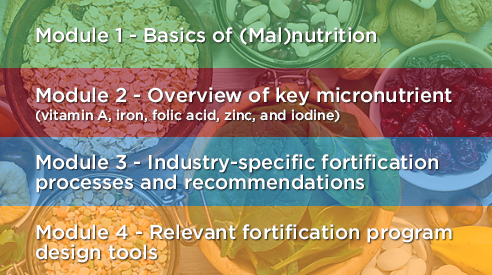
The comprehensive Introduction to Micronutrients and Food Fortification Training is a remote training program that provides an in-depth analysis of key micronutrients (vitamins and minerals) and staple food fortification processes.
The course objective is to ensure that participants have a strong working knowledge of:
Basic nutrition concepts, micronutrient interventions, and how key micronutrients used in fortification programs function in the body;
The process of food fortification as it relates to commonly fortified food vehicles and the components required to establish an effective fortification program.
Trainings include summary documents and slides, relevant readings, and topic-specific self-evaluations. Every week (or a selected time frame agreed upon by the student(s) and facilitator), a different topic accompanied by a topic-specific evaluation is presented to students. Evaluations are reviewed by the facilitator and returned to the student for further learning.
The four modules, which participants move through at their own pace, are:
Basics of (Mal)nutrition
Section I
Under-nutrition and how it is measured
What are micronutrients and why are they important
An introduction to fat soluble and water-soluble vitamins
Demystifying recommended daily allowances (RDA), reference nutrient intake (RNI), dietary reference intake (DRI), estimated average requirement (EAR), and upper level (UL)
Micronutrient deficiency definitions
Section II
Interventions to address micronutrient malnutrition
Brief overview of Ready-to-Use Therapeutic Foods (RUTF), corn-soy blend (CSB), and complementary feeding
Elements required to build an effective fortification program
An introduction to key players in the field of fortification
Overview of key micronutrients (vitamin A, iron, folic acid, zinc, and iodine)
Review of micronutrient from a historical perspective
Food sources, forms, and functions
Variability of requirements across populations
Signs and symptoms of deficiencies and toxicities
Deficiency measurements (clinical, functional, and biochemical)
Recommended dosage / requirements
Nutrient-nutrient interactions
Absorption inhibitors
Stability
Interconnectedness of micronutrient deficiencies and their impact (e.g. the idea that multiple micronutrients impact single outcomes such as anemia)
Industry-specific fortification processes and recommendations
Outline of the fortification process for each major staple food vehicle including cooking oil, sugar, maize and wheat flour, salt, and rice
Recommended fortification compounds
Overview of quality assurance and quality control measures
Relevant fortification program design tools
Regulatory monitoring
Introduction to the Food Fortification Formulator
Costing models
The course was created by Project Healthy Children (PHC). The intended audience includes representatives of government ministries and partner organizations, food producers, food inspectors, and program managers. The course could be used to train staff working on fortification programs or to facilitate a baseline level of knowledge among individuals preparing to work in the area of fortification. Students who successfully complete the course will receive a certificate of completion.
For information contact info@ffinetwork.org.
Training: Fortification Monitoring
Fortification monitoring offers online training for flour and rice programs
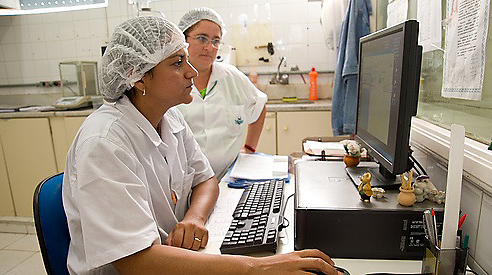
Photo: David Snyder/CDC Foundation
Fortification Monitoring is an online training tool to teach basic concepts of internal, external, import, and commercial monitoring. It is available for flour and rice fortification. The course was created in collaboration with FFI, the Global Alliance for Improved Nutrition (GAIN), and the IGP Institute at Kansas State University.
The tool guides participants in planning for a monitoring system; engaging in internal, external, import and commercial monitoring activities; and collating, reporting and using monitoring data. Videos, photos and examples enhance the monitoring concepts. Data collection forms are provided to facilitate country-based monitoring activities.
The online course consists of nine modules. The topics are:
Introduction
Why Fortify?
Multi-Sector Alliance and Planning for Fortification Monitoring
Standards, Premix and Laboratories
Internal Monitoring
Regulatory Monitoring Part I: External Monitoring
Regulatory Monitoring Part II: Import and Commercial Monitoring
Quality Management Systems
Reporting and Using Data
Participants move through the modules at their own pace and can access videos after each module before going to the next segment. The videos can be streamed with an Internet connection or downloaded for viewing later.
The intended audience includes representatives of government ministries and partner organizations, flour millers, food inspectors and laboratory technicians. The course could be used to guide country leaders who are planning for fortification, to train staff working on fortification programs, or to facilitate a baseline level of knowledge among individuals preparing to attend a fortification workshop.
For information contact info@ffinetwork.org.

